KEHEN TEMPLE
KEHEN TEMPLE OR TEMPLE OF FIRE IS A BEAUTIFUL TEMPLE WITH CANDI KURUNG IN ENTRANCE GATE
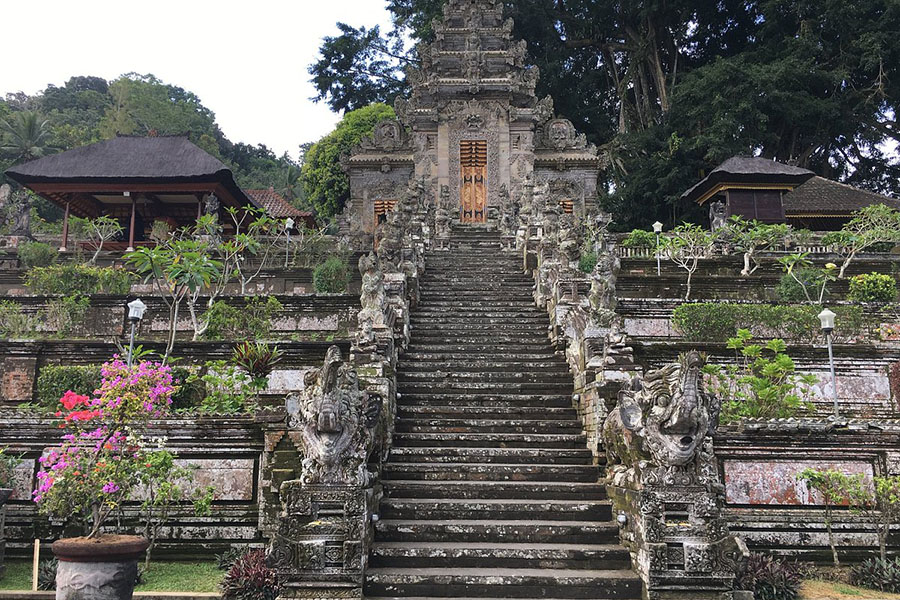
Kehen Temple is a Hindu temple complex in Bangli village. It is an important holy temple for Hindus known as Hyang Api Temple. This temple has much uniqueness, from its strategic location to its attractive entrance using Candi Bentar with Balinese carvings, similar to other Khayangan Jagat temples. What makes Kehen Temple different is the use of Candi Kurung as its entrance, creating a stunning background for Instagrammable photos. In addition to the beauty of the Candi Kurung, Kehen Temple also offers a charming view of the Bangli Hills to its north, becoming an additional attraction for visitors who want to enjoy the beauty of nature.
If you visit Kehen Temple, here’s what you need to know:
- Location of Kehen Temple
- Classified as an Ancient Temple in Bali
- History of Kehen Temple
- Association Kehen Temple with Bangli Village
- The Uniqueness of Kehen Temple
- Kehen Temple Structure
- Ceremony at Kehen Temple
- About Kehen Temple
Location of Kehen Temple
Kehen Temple is located in Cempaga Village, Bangli District, Bangli Regency. If you are driving from Denpasar, the trip will take about 2 hours with a distance of about 43 kilometers. To make it easier to find the location, you can use Google Maps. However, if you want to be more practical, we from Bali Exotic Tour provide transportation services to Kehen Temple with affordable prices and satisfying services. The drivers are friendly and experienced, which will make your trip enjoyable. In addition to enjoying the beauty of Kehen Temple, Bangli also has other interesting tourist attractions that you can see in Bangli places of interest. This can save your travel time while enjoying the charm of Bangli, which is in the Highlands.
Classified as an Ancient Temple in Bali
Bangli Regency was once the center of a kingdom that was also named Bangli. The Bangli Kingdom was one of the nine kingdoms in Bali. The name Bangli comes from the word “Bang Giri”, which means “red forest” or “red mountain”. Bangli Regency was founded by the Gelgel Kingdom of the Majapahit dynasty. Based on ancient inscriptions, Kehen Temple is one of the oldest temples on Bali Island, and this is evident from the findings of several inscriptions there. Kehen Temple is located at an altitude of 483 meters above sea level, precisely at the foot of the southern Bangli Hills, which offers a beautiful view due to its high location.
History of Kehen Temple
Kehen Temple has a very ancient history and is similar to other ancient temples in Bali. Previously, the name of Kehen Temple was known as Hyang Kehen, this can be seen from the inscriptions found. Kehen Temple is mentioned in three copper inscriptions found on Bali Island in 9 ADS, early 11 AD, and 13 AD. This information was described by P.V. Van Stain Callenfels and published in the book “Epigraphina” in 1926.
- Inscription I: The first inscription, thought to date from the IXth century, mentions the names of Hyang Api, Hyang Karinama, and Hyang Tanda, as well as the names of priests. The inscription is in Sanskrit and ancient Balinese, consists of 18 lines, and mentions the name “Hyang Karinama”… Hyang Api in the village of Simpat Bunut (“Hermitage in Hyang Karinama no Hyang Api… in Wanua in Simpat Bunut – Hyang Tanda”). The names of monks are also mentioned in this inscription. Although not numbered, this inscription is classified by Dr. R. Goris into the Saka year of about 804 – 836 (or about 882 – 914 AD).
- Inscription II: The second inscription, in Old Javanese, mentions “Senapati Kuturan”. It is the last of the two inscriptions, consists of 10 lines, and is in Old Javanese. It mentions names such as Senapati Kuturan and Saphata, as well as the names of the king’s officials. Although it has no year number, this second inscription is classified by Dr. R. Goris into the Saka year between 938 – 971 (or around 1016 – 1049 AD).
- Inscription III: The third inscription, which is in Old Javanese script and dated Saka 1126 AD or 1204 AD, mentions Hyang Kehen, which was ruled by Bhatara Guru Sri Adhikunti Ketana. The inscription is in copper and addressed to the local people, informing them that a ceremony was held at Kehen Temple in the year Saka 1126 (1204 AD), with the names of King Sri Dhanadhiraja and his consort Bhatara Sri Dhanadewi recorded in the ceremony. King Sri Dhanadhiraja was the son of King Bhatara Parameswara, and his mother was Bhatara Guru Sri Adhikunti. The inscription also states that Kehen Temple is dedicated to Hyang Api (Fire God), previously known as Hyang Kehen Temple.
From the etymological analysis of the inscriptions mentioned, it can be estimated that the development of the name from Hyang Api found in Inscription I to Hyang Kehen in Inscription III and then to Kehen Temple as it is today indicating that Kehen Temple already existed in the period around 804 – 836 Saka (882 – 914 AD). This means that Kehen Temple has existed since the end of the IXth century or the beginning of the Xth century AD. Thus, Kehen Temple can be included in the category of ancient temples on Bali Island.
Association Kehen Temple with Bangli Village
The existence of Kehen Temple has a connection with the history of Bangli Village, which can be concluded from the Kehen Temple Inscription 705. This inscription records that in the year Saka 1126 Wesaka, tithi daca mi sukla paksa, ma, Kaca, waraning Krulut, which means (May 10, 1204, AD), King Ida Bhatara Guru Sri Adhikunti Ketana, who was the King of Bangli city at that time, issued a Bhsmaya (order) for all Bangli villagers to return to their respective villages. This shows the strong connection between Kehen Temple and the history and life of Bangli Village during that time.
The Uniqueness of Kehen Temple
Kehen Temple is indeed unique among other Hindu temples on Bali Island. This specialty makes it an attractive destination for tourists, both foreign and domestic. One of the uniqueness of Kehen Temple lies in the Candi Kurung in the front area, as well as Bale Kulkul, which is located on a banyan tree. In addition, this temple also has several ancient statues that are still well preserved, serving as a reminder of the history and majesty of Kehen Temple.
- Candi Kurung in Kehen Temple is indeed a special attraction because it is rarely found in other temples in Bali. Usually, the entrance of the temple uses Kahyangan Jagat Temple, but Kehen Temple chooses to use Candi Kurung as its entrance. The uniqueness of the Balinese carvings on the Candi Kurung makes it very interesting and beautiful, so many tourists who come to Kehen Temple want to take pictures in front of the Candi Kurung. The resulting photos are quite Instagrammable. For those of you who visit Kehen Temple, this can be a valuable moment to take a photo here as a memento that you have visited the ancient temple known as the Temple of Fire.
- Bale Kul Kul is usually found in a building specifically for Kul Kul, but in Kehen Temple, Bale Kul Kul is located on the trunk of a Banyan tree. The banyan tree that grows large in the Kehen Temple area has a high sacred value for the local community. They strongly believe in the omens that come from this banyan tree. If the trunk is broken, it is considered a sign of a major event or disaster. This belief has been based on hereditary experience for hundreds of years.
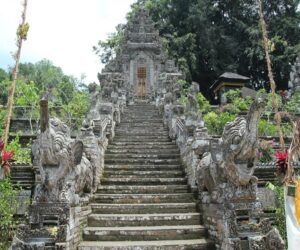 |
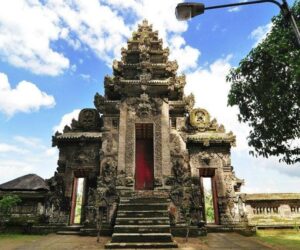 |
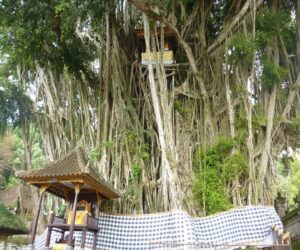 |
Kehen Temple Structure
The structure of a Balinese temple usually consists of three connected courtyards, namely the outer courtyard, the central courtyard, and the inner courtyard. Each courtyard has its own significance, and this applies to every temple in Bali, including Kehen Temple. Kehen Temple follows the same structure pattern as other temples in Bali, which is divided into three courtyards as follows:
- The first courtyard in the temple structure is called Nista Mandala, often called Jaba Sisi, which is also known as the outer courtyard. Inside the Nista Mandala area, there are several temple buildings, such as Bale Gong, a sacred stone temple, Bale Agung, Bale Kulkul, Batara Sading Bingin Temple, Batara Kebo Suih Temple, Ratu Mas Ayu Panganten Temple, and Batara Manik Aseman Temple.
- The second courtyard in the temple structure is called the Madya Mandala, or Jaba Tengah. This section serves as a separator between the first courtyard (Nista Mandala) and the third courtyard (Utama Mandala). In the Madya Mandala area, there are several sacred buildings (pelinggih buildings), such as Bale Pasangkepan, Bale Wayang, Bale Semar Pegulingan, and Pelinggih Batara Sakti Ratu Mas Subandar. In addition, the Perantenan area in the southwest of the Central Mandala acts as a place to prepare ceremonial offerings and provide food for pilgrims and temple administrators who organize visits to Kehen Temple. Bale Pewaregan is also located in the Madya Mandala, serving as a place for temple administrators, pemedek, or penangkil to take food and drinks, especially for those who live far from the temple location.
- The third courtyard, known as the Third Mandala, Main Mandala, or Jeroan, is the most holy and sacred part of the temple structure. Here, there are various sacred buildings (Pelinggih Building) that become the center of offerings and respect, including Bale Penglipuran (Pelinggih Batara Sakti Dahaning Gunung), Pelinggih Batara Sakti Pasek Majambul, Pelinggih Batara Sakti Gede Penarikan, Pelinggih Batara Sakti Taman Sari, Pelinggih Sangran, Pelinggih Batara Sakti Gede Sema, Pelinggih Batara Sakti Gunung Kaloka, Pelinggih Batara Sakti Gunung Tengah, Pelinggih Batara Sakti Gunung Sari, Pelinggih Ratu Ngerurah, Pelinggih Batara Sakti Swaring Jagat/Corong Agung, Pelinggih Batara Sakti Pinggihyang Hyang Kehen, Pelinggih Batara Sakti Hyang Karimana, Pelinggih Batara Sakti Dalem Bujangga, Pelinggih Basis, Bale Peselang, Bale Panggung, Pelinggih Batara Sakti Bukit Jati, Pelinggih Batara Sakti Ngurah Sakti, Pelinggih Batara Sakti Gunung Agung, Pelinggih Batara Sakti Maspait, Pelinggih Mantra Tirta, Pelinggih Batara Sakti Gede Pande, Bale Pasamuan Parepen, Bale Pasamuan, Bale Pawedaan, Bale Pidpid, Bale Pesandekan. In addition, there is Penyineban Temple to the south of Kehen Temple, which serves as a storage place for inscriptions. This third courtyard is the center of religious and cultural activities that are very important in Balinese temple life.
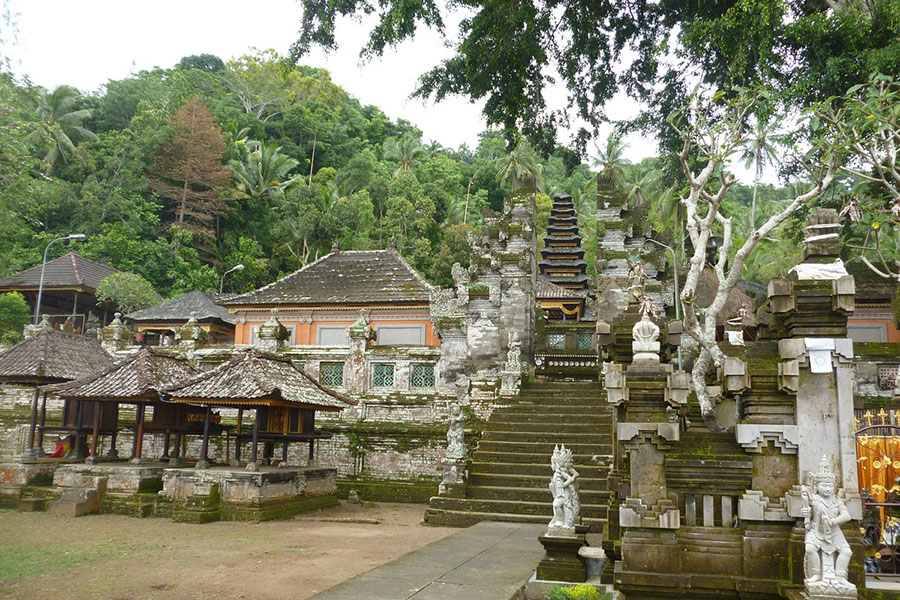
Ceremony at Kehen Temple
Kehen Temple holds ceremonies on certain days, which are adjusted to the Balinese calendar and year. There are ceremonies that are held regularly every year, and there are also major ceremonies that are held every three years. Details on the Kehen Temple ceremony schedule can be found below. If you are in the vicinity of the temple during the ceremony, it is advised not to enter the temple to respect the ongoing ceremony.
- A routine ceremony held at Kehen Temple once every six months, according to the Balinese calendar, is the Piodalan, which falls on every Buda Keliwon Wuku Sinta, which coincides with the Pagerwesi day. This ceremony usually lasts for five days, and every day during the ceremony, all Banjars from the villages of Cempaga, Kawan, Bebelang, Demulih, Penatahan, Tanggahan, Pukuh, Kubu, and Penglipuran perform prayers alternately with Mepeed ceremonies.
- The main-level ceremony at Kehen Temple, which is held every three years, is called Karya Agung Bhatara Turun Kabeh or Ngusaba Dewa. This ceremony occurs on the fifth sasih, known as the month of Karya Agung. The estimated execution of the ceremony occurred in October 2015 on Purnama Kalima and usually lasts for 9 to 11 days. One of the highlights of the ceremony is the Melasti procession, where all the pratima, tapakan, and sacred objects from the Loaduan area, which consists of about 19 traditional banjars, participate in the procession. They perform the Melasti ceremony at Watuklotok Beach, Tirta Sudamala, or Tamansari, with thousands of people and dozens of groups carrying Gambelan with Baleganjur music as accompaniment. This procession reflects the togetherness of the Bangli community colored by manners, especially from the customs of the Beratuan Kehen Temple known as Gebog Domas. During the ceremony, the stakeholder villages take turns performing sacred dances such as Baris Dadap, Baris Perasi, and Baris Gowak, as well as Rejang and Pendet dances.
About Kehen Temple
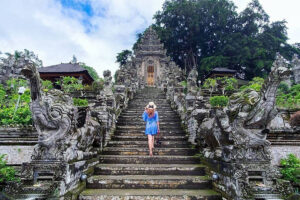
Kehen Temple is believed to have existed since the megalithic era, with sacred stones as relics that are still respected by the local community. However, the development of this temple took place after the arrival of Danghyang Nirata, who brought sikil candi, so that Kehen Temple was then built in accordance with other temples in Bali. This is evident from three inscriptions that provide clues to the evolution of the temple’s name and beliefs. Inscription I describe the change of name from Hyang Api to Hyang Kehen. Inscription III, name “Kehen”, meaning “Cool, Brazier, Place of Fire”, describes the adaptation of beliefs from previous natural forces (Hyang Api, Hyang Tanda, and Hyang Karimana) into Hindu beliefs into the Tri Murti Gods (Gods Brahma, Vishnu, and Shiva). The community of Cempaga Pakraman Village always encourages maintaining the sanctity and preservation of Kehen Temple as an important part of the historical and spiritual heritage of Hindus in Bali.

